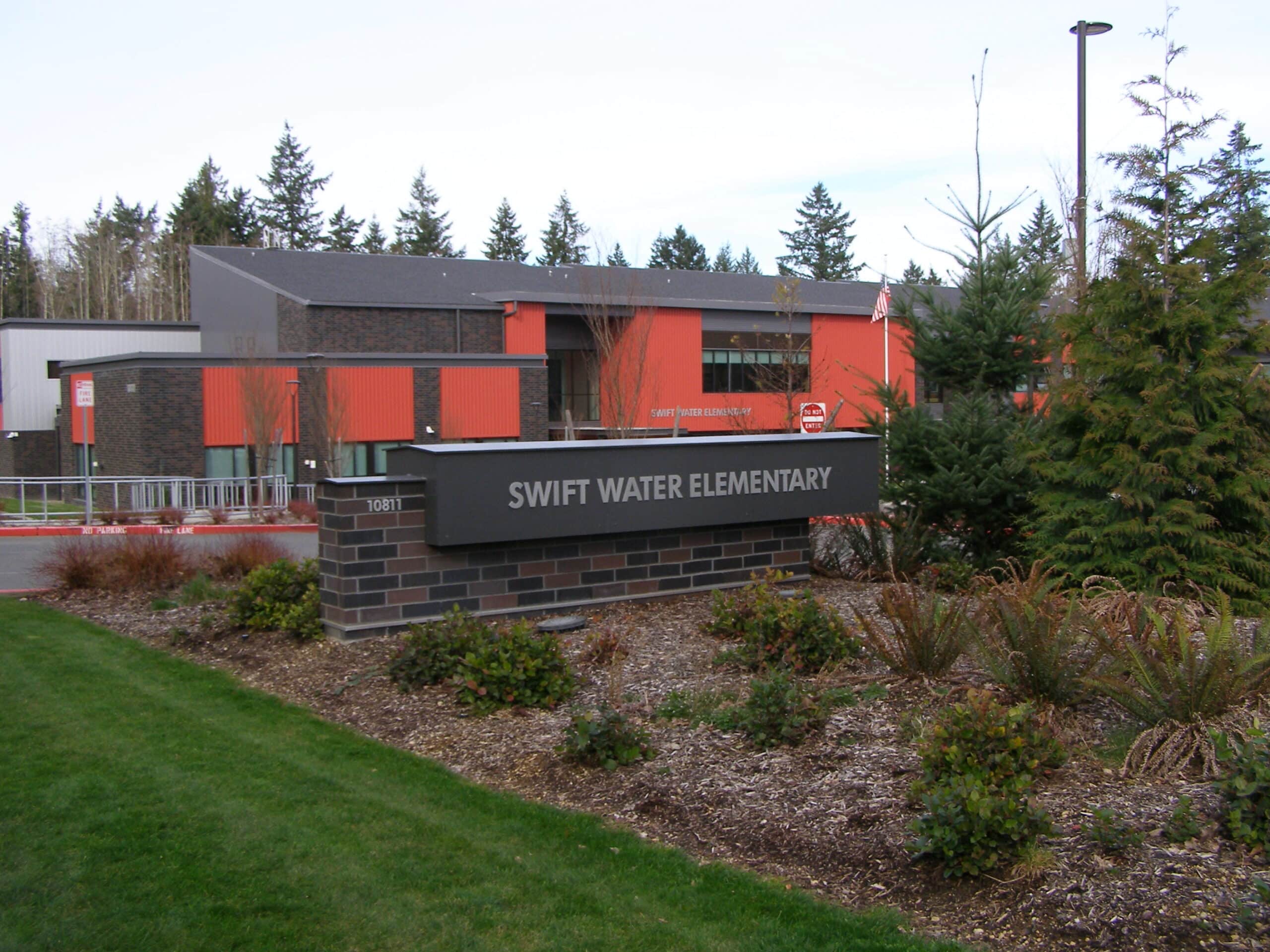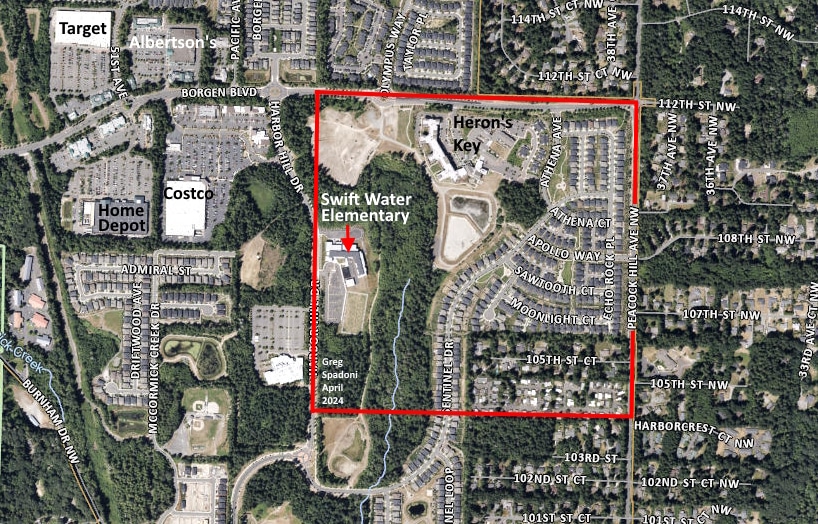Arts & Entertainment Community
Gig Harbor Now and Then | Which government agency originally owned the land where this school now stands?
The last three Gig Harbor Now and Then columns have not posed any questions of local history. We will return to that format this week, somewhat under duress.
Arts & Entertainment Sponsor
Arts & Entertainment stories are made possible in part by the Gig Harbor Film Festival, a proud sponsor of Gig Harbor Now.
There’s a rumor floating around that unless we return to posting questions, we might be replaced by a new column. If you think we’ve been writing boring stuff, get a load of the rumored replacement’s subject: clothing fasteners.
That’s not the subject of one, single story, but of a continuing column.
I managed to get a sneak peek at the first one, and the title ought to tell you everything you need to know: Shoestrings: Fit to be Tied.
Yes, it’s every bit as boring as it sounds.
The second entry is titled The Bathrobe Sash: True Fastener or Simple Accessory?
I know what it really is – it’s trash. The whole idea is just stupid.
The editor hasn’t said anything to me about being replaced — even temporarily — so the rumor might not be true. But just to be on the safe side, I’m going write one of those columns myself to make sure I don’t get cut out entirely. I won’t do a dull one like the others, though. I’m going to make the subject exciting. I don’t yet have the story, but I’ve got the perfect title: Zippers of the Kalahari.
As anybody can tell you, once you’ve got a good title, the story easily follows.
Given a dashing, exciting title like that, imagine a sweeping epic on the scale of Lawrence of Arabia. How hard could it be to write another one of those?
With any luck, that column will never be seen here though, for we’re going back to posing questions of local history, starting this very week. And we’ve got an especially good one. As fine as the question is, though, the answer is even better. We’ll present the answer on May 6, but now it’s time for the really good question.
Educating the public
One of the several goals of Gig Harbor Now and Then is to educate, and today we will attempt to do that by talking about education. Peripherally, anyway.
It’s no surprise that the Peninsula School District’s Swift Water Elementary School in the north end of Gig Harbor occupies land owned by the district. What probably is a surprise is how long ago that same property was dedicated to the purpose of supporting education.

Swift Water Elementary School
Beginning in the late 1700s, it was a policy of the U.S. government to set aside certain amounts of land in every new state admitted to the Union for the benefit of education in that state. By the time Washington Territory became the state of Washington in 1889, the federal government was dedicating two out of every 36 sections for primary and secondary schools, and often many more sections for colleges and universities.
Sections 16 and 36 in each township were always the first choices for primary and secondary schools, but if those were unusable land —underwater, for example—or had already been sold to private parties, other sections would be selected.
Commonly referred to as school land and university (or college) land, the intended use of the real estate was not necessarily for the location of schools or colleges. That was always an option, but the primary purpose was for the funding of education.
After all, each section contains one square mile of land, which is far beyond the needs of a single school house. The land funded education by being leased, sold, mined, logged or otherwise used to raise revenue. The proceeds were used exclusively for education purposes.
Today Swift Water Elementary School occupies a small portion of the northeast quarter of Section 31, which lies at the southwest corner of the intersection of Borgen Boulevard and Peacock Hill Avenue in Gig Harbor.

Swift Water Elementary School in Gig Harbor occupies 14 acres of a quarter-section of land reserved over 150 years ago for the benefit of education. The 160-acre quarter section is outlined in red. Pierce County Assessor-Treasurer aerial base map.
When the first private citizen to own the northeast quarter of Section 31 bought it in 1872, long before Washington Territory became a state, the seller was a government entity, holding it for the benefit of education in its jurisdiction. It had been granted the land by the federal government. Under certain circumstances, the federal government would occasionally grant school and university land to territories, but that did not apply in this case.
This week’s question:
What was the name of the government entity in possession of the land in 1872?
If you’re skilled at tracing land ownership back more than 150 years, the question is a very easy one. If you’re not, it’s practically impossible.
From an interesting question to a real snoozer
Perhaps not for the first time, and almost certainly not the last, we’re going to end this week’s column with a sedative. This time it’s in the form of a short history of Crescent Creek Park, as posted on the city of Gig Harbor’s website. How many errors of history can you spot?
Coming from the city of Gig Harbor, there are plenty to choose from.
If we researched every point, perhaps there would be more, but here are the errors we found (18) on a quick read through:
City Park History – Crescent Creek
Earliest Years
Commercial logging started in North Gig Harbor in the late 1800s. Gig Harbor Timber Co. and D. Cavalero logged Crescent Valley by railroad for more than seven years starting in 1908. The 4-mile rail line ran along the ridge above the creek to the bay. A boom crew tipped the logs off the loaded cars from a trestle just west of Randall Drive NW.
Crescent Creek runs three miles from Crescent Lake to Gig Harbor Bay. After logging cleared the valley of its old-growth forest, families began to homestead the area, making their living through ranching, farming, and dairy operations. Crescent Valley residents would use the railroad track as their path into town, since it was an easier walk than on the trails. Evidence of the rail’s roadbed can still be spotted in Crescent Valley.
Crescent Valley School was built in 1915 located on the corner (Vernhardson / 96th and Crescent Valley Road) where the old Masonic Temple structure still stands. Children enjoyed fire drills as they were allowed to slide down the chute-style fire escape from the upper floor. The first primary grade teacher was Lucy Goodman of Crescent Valley. She was paid $65 for 36-weeks of teaching. The school ceased operations in 1941 when the school district consolidated. The building was purchased in 1949 and remodeled by the Masonic Temple Association.
Park Donation
In 1948, the Peninsula School District donated the park to the City. The restrooms, stone wall, and water fountain were built through the Works Progress Administration program in 1936-1937 [-1939]. For over four decades, it was the City’s only community park and the location of many traditional church-related and family events. The park was renamed Crescent Creek Park in the late 1990’s.
The Park’s large, open-air structure, natural creek bed, and specimen trees represent an important historic landscape that embodies Gig Harbor’s early rural lifestyle. Still known to long-time residents as “City Park” it was the first (and for many years) only park within city limits. It signifies a national economic period of significance with architectural characteristics of a type, method of design, and construction typical of WPA projects around the country. The WPA picnic structure at City Park was added to Gig Harbor’s Register of Historic Places in 2015.
Commemorative WPA Plaques
Franklin Delano Roosevelt’s New Deal cultural programs marked the U.S. government’s first big, direct investment in cultural development. The largest and most important of his “New Deal” programs launched in the spring of 1935. Projects for the construction of recreation facilities were found to be excellent for the employment of large numbers of common laborers, as well as a small number of skilled workers. The most important of these projects were in parks, ranging from small parks in the rural communities to the larger state parks on which thousands of men were employed.
Records from 1935 list three Works Progress Administration (WPA) projects associated with schools in the Gig Harbor area. One of them was Crescent Valley School built in 1915 just above what is now Crescent Creek Park. Records indicate that the sidewalks from the school were built under WPA at 50 cents a linear foot. The work to construct the open-air park facility in 1936 employed workers at $55 a month: 6-hour days, 5 days a week. A plaque in commemoration of the 1937 [- 1939] construction is mounted on the water fountain near the shelter.
With the sedation now over, we offer the following as a public service:
WAKE UP!
While we noted the errors, we will not provide the corrections, for that would require a re-reading of the text, and nobody needs to go through that again, do they?
No. Once is quite enough … if not once too many.
We’ll have the answer to the Swift Water Elementary School land question on May 6. It’s not only a really good one, it’s also 100% sedation free.
Greg Spadoni of Olalla has had more access to local history than most life-long residents. During 25 years in road construction working for the Spadoni Brothers, his first cousins, twice removed, he traveled to every corner of the Gig Harbor and Key Peninsulas, taking note of many abandoned buildings, overgrown farms, and roads that no longer had a destination. Through his current association with the Harbor History Museum in Gig Harbor as the unofficial Chief (and only) Assistant to Linda McCowen, the Museum’s primary photo archive volunteer, he regularly studies the area’s largest collection of visual history. Combined with the print history available at the Museum and online, he has uncovered countless stories of long-forgotten local people and events.

